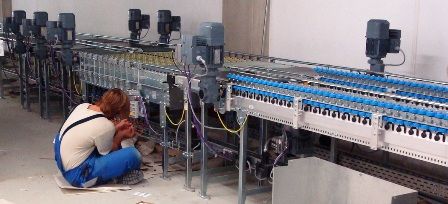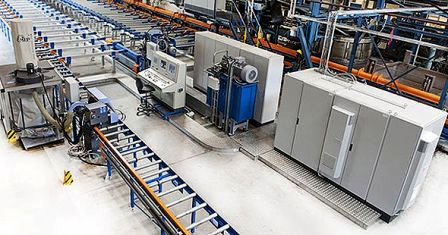Conveyor and conveyor control systems
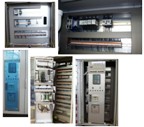
The most complex are the conveyor control schemes of conveyor systems. Interlocking must be provided for co-operating conveyors to ensure that the motors are started and stopped without blocking the transported load.
Conveyor motors are started in sequence opposite to the direction of movement of the load, and the line stop is initiated by turning off the conveyor motor from which the load enters the following conveyors.
A complete shutdown of the line can also occur when the motors are switched off simultaneously. At a stop command, the delivery of cargo to the main conveyor stops and after the time required for the cargo to travel the entire route of the line, all motors are automatically turned off. When one conveyor stops, the motors of all the conveyors feeding the stopped conveyor must stop and the following conveyors can continue to operate.
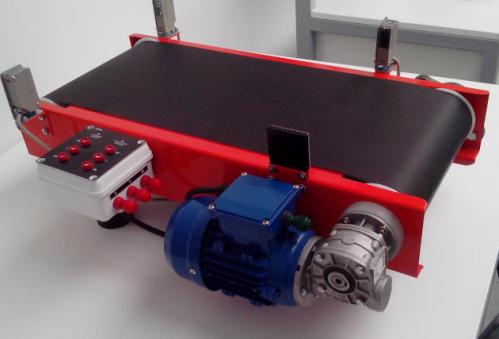
Load balancing in variable speed drives
In long-length conveyors with multi-motor electric drive, the task is to automatically control individual motors to redistribute the load between them and ensure uniform tension of the belt along its length. This applies to both constant belt speed operation and the conveyor starting process.
Automation of conveyor systems
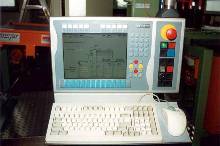 The level of automation of conveyor systems is determined by the degree of automation of control functions, the technical means used and the type of structure of the control system.
The level of automation of conveyor systems is determined by the degree of automation of control functions, the technical means used and the type of structure of the control system.
Automated control systems (ACS) of conveyor installations perform the following functions: automation of starting and stopping groups of electric motors from the central control panel, monitoring the entry into service of each machine, monitoring the state of the mechanisms of all machines in the group, performing individual auxiliary operations during the continuous movement of goods (accounting, dosing, regulation of productivity, etc.), automation of loading, unloading and distribution of goods at certain points-addresses with the help of automatic cargo addressing systems, control of the filling of bunkers and issuing goods depending on their filling.
According to the type of structures, ACS conveyor plants are divided into centralized and decentralized control systems, as well as systems with a mixed structure, and all three types of structures can be single-level and multi-level. For complex ACS with pipeline installations, it is advisable to recommend a decentralized multi-level ACS for use.
The structure of ACS with conveyor installations includes a number of practically autonomous subsystems. There are usually four such subsystems: technological control and information presentation, automated control, regulation, technological protections and interlocks.
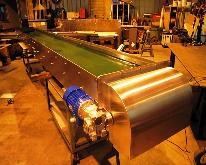 Subsystem of technological control and presentation of information performs: control (measurement, presentation), signaling, registration, calculation of technical and economic indicators, communication with other subsystems of the automated control system through conveyor installations.
Subsystem of technological control and presentation of information performs: control (measurement, presentation), signaling, registration, calculation of technical and economic indicators, communication with other subsystems of the automated control system through conveyor installations.
Information about the status of conveyor systems and their drives comes from sensors, position indicators, from limit and travel switches, auxiliary contacts of starters, contactors and functional equipment. The control of the parameters of the conveyor installations, information about which is required by the service personnel constantly, is duplicated by separate measurement sets for continuous operation.
The control of the presence of a load on the belt, plate, etc. is carried out in order to prevent overloading of the working body, as well as overflow of transfer devices at the transfer points. As sensors for the presence of cargo in the considered subsystem, contact (push-type sensors) and non-contact sensors are used. Inductive, radioactive, capacitive and photoelectric sensors are used as proximity sensors.
The presence of a load on the belt is monitored using sensors that close the electrical circuit when the impulse device deviates from the mass of the moved load. The impulse element in a particular case can be made in the form of a blade or a roller.At a certain load, the hanging branch of the movable belt rotates the rotor of the sensor, turns on the alarm and turns off the electric drive of the conveyor. When transporting a piece of goods, if they are reloaded from one conveyor to another, the minimum permissible intervals between individual goods are observed.
The control of cargo traffic on the conveyor belt can be carried out with the help of coaxially located sources and receivers of radioactive radiation. The radioactivity signal, the level of which depends on the thickness of the layer of material on the spill, is converted and sent to display device, and then to the servo motor that controls the hopper door. At the same time, the signal from the transducer is fed to the integrator, which indicates the amount of transported cargo.
Control of the avoiding belt can be carried out using the AKL-1 apparatus, the principle of which is based on the rolling of the control roller on the non-working side of the belt. In the absence of a tape above the roller, the lever under the action of the load rotates and turns off the starter of the latter. Non-contact sensors, for example, photoelectric sensors, which are made in the form of photocells with an external photoelectric effect, photoresistance or photocell with a blocking layer, can also be used to control the tape leakage.
The control over slipping and breaking of the belt is carried out by a device that also reacts to the breaking of the belt, violation of the integrity of the roller bearings and the operation of the engines. The principle of operation of the device is to determine the time of revolution of the lever fixed on the axis of the driven drum of the conveyor.As the lever revolution time increases, which can only be caused by belt slippage, a signal is given to turn off the feed and slide conveyors.
The control of the movement of the traction bodies is carried out with the help speed relay, which are divided into mechanical (dynamic, centrifugal, dynamic inertial, hydraulic) and electrical (inductive and tachogenerator).
On a belt conveyor, the location of the speed switch can be determined arbitrarily, since the speed of the belt along the length of the conveyor does not change in any mode (it is usually placed on the shaft of the tail drum). The location of the speed relay on long conveyors has a significant impact on the reliability of the process control subsystem (the most dangerous is the breakage of the drive gear), so the speed relay is installed on the empty branch after the drive.
Overload points are controlled by blocking alarms at the transfer points, the operation of which is based on the deviation of the moving element, for example, to the sensor board, which turns off the motor of the feed conveyor.
The control of the degree of filling of the hopper installations is carried out by installing sensors for the upper and lower level of the material, which makes it possible to automatically turn off the engine of the cargo conveyor when the hopper is overflowing and of the engine of the conveyor to which unloading is carried out, in the absence of material in the hopper.
Rail automation sensors determine the constant connection of the moving chain, trolleys, hangers and individual transport mechanisms to the process control subsystem. The movable element in one way or another (most often through mechanical contact) acts on the probe of the sensor, which transmits a signal directly to the sensor, for example, to a contact or a non-contact limit switch.
Track automation sensors ensure the correct operation of transfer devices, control the relative position of bogies with suspensions and perform other similar operations during conveyor operation.
For example, in modern pusher conveyors there are mainly three unified types of sensors, bogie, pusher and free pusher. In rail automation sensors in modern design, the actual sensor is an inductive sensor with proximity switch.
The subsystem for technological control and presentation of information must be equipped with two-way sound operational and warning signaling, in particular, the start of the conveyor must be preceded by sound signaling.
A subsystem for automated control of conveyor installations performs the following functions: sequential starting of the engines of the conveyor line in an order opposite to the direction of the load flow, with the necessary delay between switching on, stopping the entire line from the central control panel and each conveyor of the installation place, local starting each conveyor (with interlocks disabled) in both directions during setup, adjustment and testing of the line, automatically bringing the control circuit to the «off» position in the absence of voltage.
Normally, the start button is placed on the central control panel, and the stop buttons are located in several places in each individual production room, in the transition galleries, at the actuators, in the loading and unloading area - for quick emergency stop of the conveyor and prevent of incidents. When one conveyor in a production line stops abnormally, all previous conveyors are immediately stopped.
Automatic addressing of goods when using conveyor systems is related to solving the following tasks: sorting of packaged goods according to certain sections of the warehouse, racks, stacks, air tracks, vehicles, distribution of bulk goods between bunkers, silos or piles, with issuing of bulk and piece goods in a predetermined sequence from piles, racks, containers, silos, accumulating sections from various conveyors to certain points in the warehouse, to a conveyor, vehicle, etc.
In the automatic addressing of packaged goods, two methods are used: decentralized, when the address carriers are the goods themselves, and centralized, when the route of the goods is set on the control panel.
The principle of operation of decentralized addressing systems is based on the matching of the program applied to the address carrier and the receiving (reading) device configured for this program. In such systems, the actuating elements (arrow drives, roller joggers, chain conveyors) receive commands directly from the addressed object. The main types of systems for decentralized addressing of a piece of goods are electromechanical with spikes or pins, photoelectric, electromechanical flag, optical, electromagnetic.
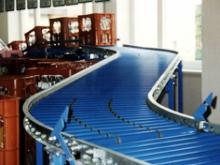 The regulation subsystem performs the following functions: obtaining information about the current value of the controlled parameters, comparing the current values of the controlled parameters with the preset values, forming a regulatory law, issuing regulatory actions, exchanging information with other subsystems.
The regulation subsystem performs the following functions: obtaining information about the current value of the controlled parameters, comparing the current values of the controlled parameters with the preset values, forming a regulatory law, issuing regulatory actions, exchanging information with other subsystems.
For example, a system for automatic regulation of the productivity of a conveyor installation is organized based on information received from sensors that measure the speed of movement of the load, linear load and influence the position of the gate, the speed of feeders.
A subsystem of protection and locks determines the minimization of economic losses to restore the operability of the equipment of conveyor installations. The protection and blocking subsystem fulfills its purpose by preventing or eliminating situations leading to disruption of the technological process or equipment damage.
A special role is played by the reliable operation of interlocks for adding systems of conveyor plants during the period of start-up and shutdown.
Conveyor installations are equipped with interlocks that turn off the conveyor drive when the belt slips, the transverse and longitudinal belt breaks, the belt deviates to the side beyond the established deviations, the temperature of the drums or other transport mechanisms rises above the permissible value.

